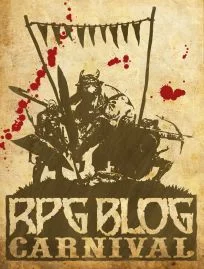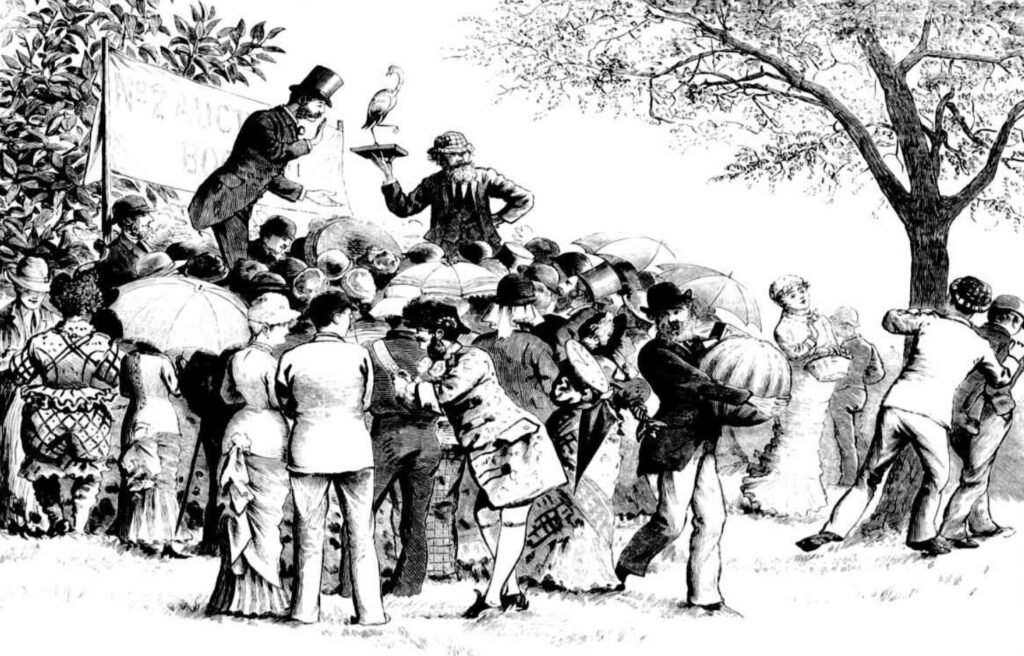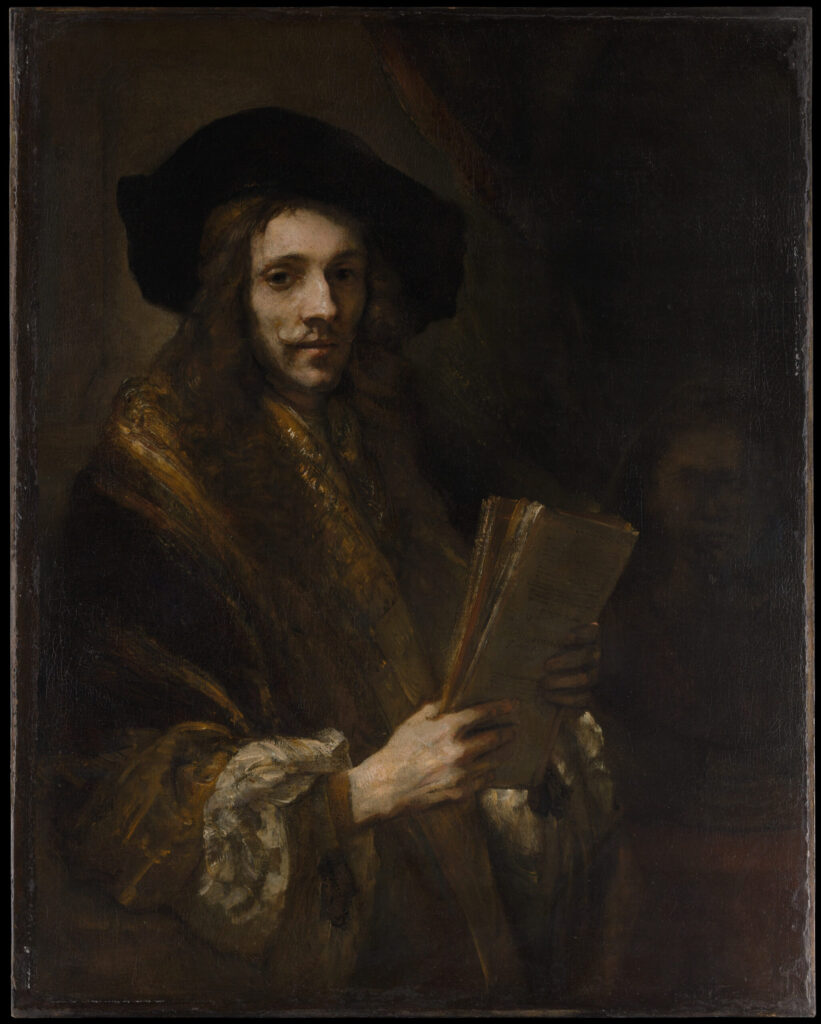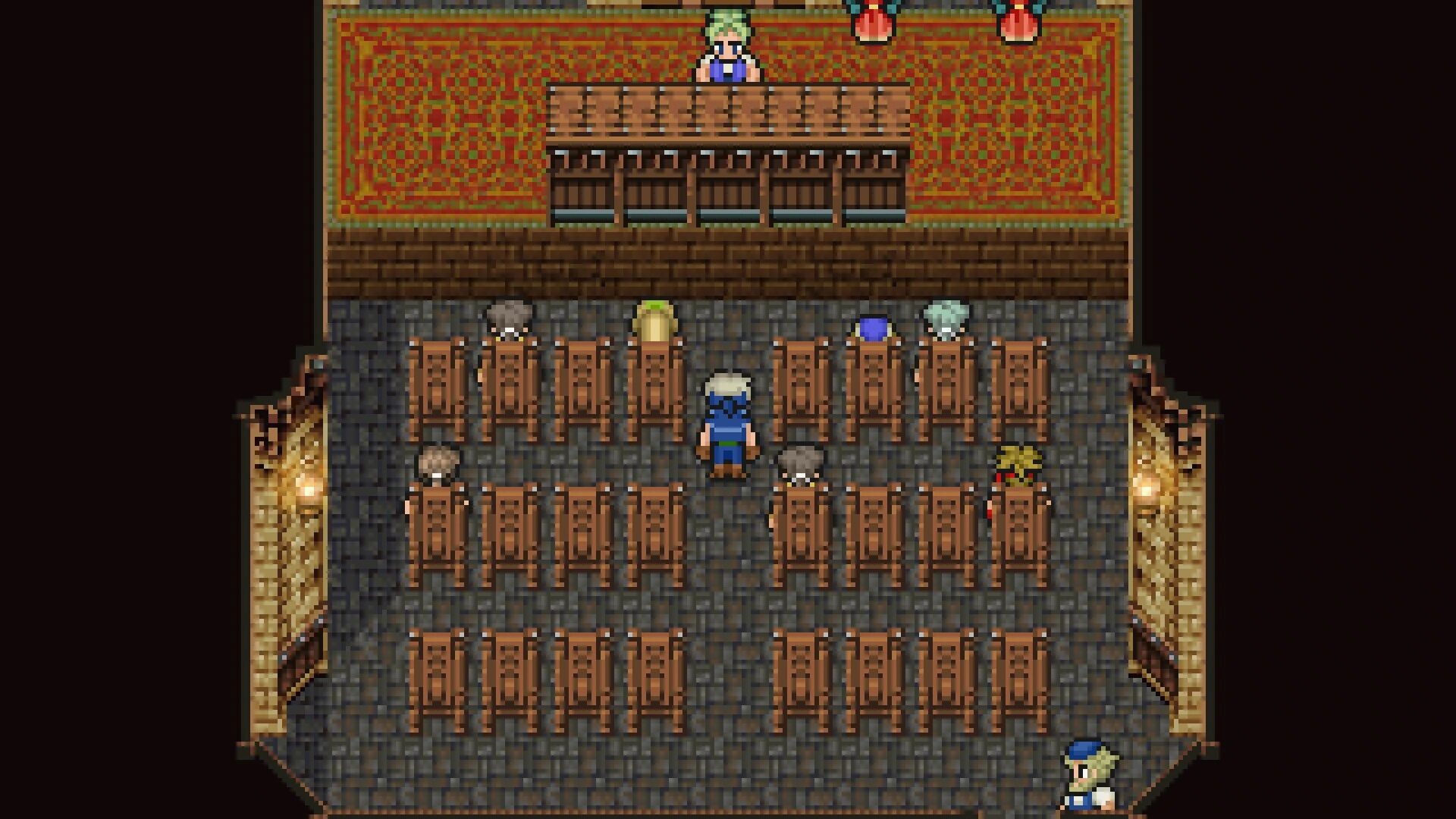In Final Fantasy 6, one of my favorite sequences is the Jidoor Auction House, a place where the player can bid against NPCs for magical items and accessories. It occurs to me that magic item auction houses are a great alternative to magic item shops in Dungeons and Dragons. Let’s talk about why.

The problem with magic item shops
I’ve always found traditional magic item shops in Dungeons and Dragons a little lacking. Many DMs present a magic item shop like this:
- You have a set list of available items with set prices.
- There’s little to no NPC interaction.
- You might get to roll some sort of Charisma check to haggle for a lower price.
- Worse still, I’ve had DMs hand me the Dungeon Master’s Guide open to the chapter on magic items and just say “here, buy what you want.”
That’s not to say you can’t make a magic item shop interesting, but I think many play groups gloss over shopping because they think shopping is boring. It’s filler content before you get back to the good stuff. But it doesn’t have to be this way!
I have a lot of issues with this method. It makes powerful magic items feel like buying mundane goods, no more interesting than buying a bag of flour or a box of matches. It feels like buying fast food.
“Welcome to McMagic, what can I get for you today?”
“Uhhhhhh, yeah, I’ll have a longsword +2 and a potion of water walking to drink.”
“Great. Would you like fries with that?”
“Uhhh, sure.”
“That’ll be 3200 gold. Next window, please.”
What if there was another way? What if there were a method that makes magic items feel unique and interesting, that creates a dynamic social encounter for the party to engage with, that can be just as entertaining as combat or dungeon delving or roleplaying?
Shopping can be the good stuff by making it the focus of the adventure.
An alternative: the magic item auction house

In my vision of magic items, they are rare and unusual items, with storied histories. I don’t like presenting players with a “longsword +2” when I can present them with “Stormrender, a sword forged by the thunder priests of Tarhun, god of lightning.”
If you can walk into any store and pick up a magical sword off a shelf, it really cheapens the feeling of them, in my opinion. But I don’t like the other extreme, where magic items are simply not available for purchase — there is always a market for rare and unusual items.
Thankfully, we have some real-world analogues to look at in the form of auctions — one-of-a-kind pieces of art, jewelry, and antiques are sold every day in auctions across the world, attracting eccentric collectors, art connoisseurs, investors looking to flip a profit, the newly rich and the old monied, all interesting characters we can draw into our games.
The rest of this article compiles some procedures for structuring a magic item auction minigame that provides ample opportunities for players to make strategic decisions, sabotage competitors, and unlock new opportunities.
What does the magic item auction look like?
There are a lot of fiddly widgets you can play around with here:
- Does the auction house have a permanent structure or is it held pop-up style on market days? Historically, high end auction houses have permanent structures of their own, while cheaper auctions may be held in public squares or shipping docks.
- Are auction days held on specific regular days of the week or month, or are they scheduled at the whims of the auctioneer?
- Does the auction house have a dress code? Some high end auctions may not allow adventurers in if they’re dressed in dungeoneering or traveling clothes, for example.
- Is the auction open to the public or is it open only to a special curated list of VIP clientele?
Who’s attending the magic item auction?
One of the most significant factors to plan for your magic item auction house is determining which NPCs will be attending. While an auction may attract a large crowd, it’s best to focus on 3-6 NPC Competitors.
These competitors may be merchants, collectors, other adventurers, nobles, or even NPCs the party has already met. Some may be professional agents who bid as proxies for wealthy patrons.
Each competitor has two statistics:
- Interest: Roll 1d6 per item up for bid. This is the Competitor’s Interest in the item and determines whether they will participate in the bidding.
- Purse. Roll 1d6 per Auction Encounter, minimum 1. This determines how many times the Competitor will offer a counter bid for each item. If a Competitor has Interest in an item, they will always counter bid at least once. Purse represents how much a Competitor is willing to spend on the auction and isn’t a direct representation of their actual financial holdings.
Modifiers.
- If the NPC has a rivalry with the party or another Competitor attending the auction, increase Interest by +1 for all items. Competitors will bid on items they otherwise wouldn’t if it means beating a rival.
- NPCs may have a special attraction to a particular class of item. A knight may be particularly interested in weapons and armor, while a priest may be interested in religious relics. In such cases, increase the NPC Competitor’s Interest in items of that category by +1.
- Some NPCs may be primarily interested in items of a particular rarity. A wizard may be primarily interested in Rare magic items. In such cases, increase the NPC Competitor’s Interest in items of that rarity by +1.
- Particularly wealthy competitors may have +1 or +2 to Purse.
- If a Competitor has won an item in an Auction Encounter, decrease Purse by 1, to a minimum of 1.
Interest and Purse scores are rerolled at the beginning of each Auction Encounter.
What’s up for bid?
While some auctions may only offer a single unique item, most will likely offer several at various price points.
- 1-2 cheap curios, common or uncommon items
- 2-3 mid-tier items, uncommon or rare items
- 1-2 rare powerful items, rare or very rare items
Cheaper items are always presented first in the auction.
This presents an interesting choice to the players. They have finite funds to spend at the auction. Cheaper items may be easier to win, but bidding on them may consume funds that they need to potentially win the more powerful items later on.
The Auction Encounter

The Auction Encounter has four phases. Conducting a full auction encounter may take an entire game session — if you’d like faster auctions, look for tips at the end of the article.
- Auction Announcement
- Pre-Auction Mingling
- Bidding Phase
- Transaction Phase
1. Announcing the Magic Item Auction
The Auctioneer will announce that a magic item auction is going to be held. The form of this announcement may vary:
- It could include posters around town, a publication in a local newsletter or could be something that other people around town are talking about.
- If the party has participated in an auction before, a messenger may be sent to directly invite them to attend again.
- How much prior notice is offered may depend on the Auctioneer’s disposition to the party. If the Auctioneer dislikes them, they may wait until the last minute to give them notice of the auction.
- Generally speaking, though, auctions should be announced 24-48 in-game hours before the auction starts. In some cases, an auction may be announced up to a week prior, but I suggest shorter timeframes to keep the Auction Encounter moving quickly.
- Some auctions may place items on display during this period, perhaps in the front windows of the auction house or as illustrations in announcement posters. Others may include only a brief description of the items on an announcement flyer or notice, while still other auctions may offer no description of the items at all.
- Players should have the opportunity to learn which NPC Competitors plan to attend the auction. This may involve reaching out to contacts, asking around town, listening to gossip, or otherwise gathering information.
- The party may be able to learn about categories of items that Competitors are particularly interested in, or may learn valuable information they can use to influence the Competitor during the Mingling phase (see below).
- Some auctions may be invite-only, in which case, players should have the opportunity to attempt to secure an invitation through deals, favors, bribes, persuasion, or other methods.
DM Prep
During this phase, the DM should determine which NPC Competitors will be attending and roll their Interest and Purse scores.
You’ll also want to know which items are available for auction.
2. Pre-Auction Mingling
On the day of the auction, there is a period where bidders gather to meet and mingle for about an hour before the auction begins.
- The Auctioneer may or may not present.
- Some or all of the NPC Competitors will almost certainly be present.
- There will also be a crowd of unimportant NPCs — these are people who arrive at the auction, but aren’t serious bidders. They may be there for the novelty of seeing what items are offered, wishful-thinkers who would like to bid but lack the means, or are just there to enjoy the spectacle of watching the auction play out.
Some auction houses, especially those with permanent facilities, may offer refreshments such as champagne, hors d’oeurves, or provide entertainment during this phase — relaxed, happy bidders are more likely to open their wallets.
The items available for bidding may or may not be displayed during this phase. If they are available for inspection, party members who choose to inspect the items should have less time for social interaction.
- The mingling crowd is a good source of rumors, information, and adventure hooks that may be useful after the auction ends.
- This phase is an opportunity for players to learn more about their Competitors. Through skill checks or roleplaying, they may be able to learn which items the Competitor is most Interested in.
- Through skill checks or roleplaying, the party may be able to affect a Competitor’s Interest in an item. For example, they may be able to bluff or persuade a Competitor that an item is not worth their time. In such case, decrease the Competitor’s Interest in the item by 1 or 2.
- On the other hand, they may convince Competitors to bid on items that the party is not itself interested in, as a way to consume Purse during the Bidding Phase. In such case, increase the Competitor’s Interest in the item by 1 or 2.
- The party could also target a Competitor’s Purse directly, by instilling economic uncertainty or suggesting that the Competitor may be able to find better deals after the auction if they save their money now. In such case, decrease the Competitor’s Purse for the Auction Encounter by 1 or 2.
Generally it’s best to limit how many Competitors the party can influence during this phase to no more than half of the Competitors present. This creates a position where the party must decide which Competitors they believe are their greatest threat or which Competitors they believe they are able to influence the most.
Don’t linger too long on this phase. Party members should be given a limited number of actions they can take — they don’t have time to seek rumors from the overall crowd, influence every Competitor, and inspect all the items. Make them choose which actions they believe are the best use of their time.
DM Prep
You’ll want to think about what rumors or information the party can learn from the crowd. It’s a great time to drop hooks for future adventures.
It’s also a good time to think about how various NPC Competitors will respond to various attempts to influence them. One NPC might be susceptible to flattery, while another may be more financially-minded. Failed attempts may backfire, encouraging Competitors to bid against the party when they normally wouldn’t.
If the Auctioneer chooses to wait to notify the party about the auction until the last minute, it’s possible for the Pre-Auction Mingling phase to be skipped entirely.
3. Opening the Magic Item Auction – Bidding Phase

The Auctioneer will arrive, if not already present, and will usually be accompanied by one or more clerks or assistants. The Auctioneer will announce the opening of the magic item auction, usually by banging a gavel or staff, or by ringing a bell or gong.
The Auctioneer will provide a description of the first item, while an assistant holds the item so the crowd can see it. There may be a demonstration of the item — a magical sword may be demonstrated by showing off its cutting power, for example, or a ring of invisibility may be demonstrated by an assistant putting it on and off a few times.
This is a great time to share some history or lore about the item. Maybe the sword was owned by the warrior priest Sir Tarant the Courageous, or the ring was forged by the wizard of the fabled Tower of Gems.
The Auctioneer will open the bidding at a designated minimum. I generally set this minimum to 25% of the expected value of the item. You can use whichever pricing method you prefer — the Dungeon Master’s Guide and Xanathar’s Guide to Everything both offer suggested magic item prices, as do many third party guides.
Most magic item auctions will also have a required increment, in ones, tens, hundreds, thousands, or other increment of the DM’s choosing. This prevents silly situations where the party only ever bids a single gold coin higher than the last NPC bid, which in my opinion takes some of the fun out of it. The Auctioneer should tell the bidders what the required increment is for each item, and the increment can vary from item to item — more expensive items will have higher increments.
Example: If the bid increment is hundreds and the last bid was 500 gold, the party will need to bid 600 gold to have the higher bid.
Generally speaking, I allow the party to make their starting bid before introducing the NPC Competitors to the magic item auction.
Is the party bidding collectively or individually?
The party will need to decide if they plan to bid on items as a collective group or as individual participants.
If bidding collectively, the party should designate a bidder for their group who will communicate bids to the DM, though they can solicit brief out-of-character input from the rest of the party.
If bidding individually, each participating party member will make their own bids, based on their personal gold. It is possible for party members to bid against each other for an item, if they both wish to possess it. In this case, each individual bidder decides whether to bid or not.
If a party member plans to bid on any item, they must declare it now and are classed as a bidder for the remainder of the Auction Encounter. Bidders cannot take actions to influence the bidding (see below).
Introducing NPC Competitors
For each item, roll a d6 and compare against the Competitor’s Interest score for that item. If the result is equal to or less than the Competitor’s Interest score for that item, they will choose to engage in the bidding for it.
Repeat this step for each NPC Competitor.
As a fallback, even if all NPC Competitors fail their Interest check, at least one (of the DM’s choosing) will make a counter bid.
Counter Bidding
If an NPC is Interested, they will make a counter bid, increasing the price by the bidding increment.
Each Interested NPC will make a counter bid, then the party may decide if they wish to continue bidding.
For example, if the party bids on an item and there are three Interested NPCs, the price will increase three increments before returning to the party.
Example: Up for auction is a Cloak of Protection, with a starting price of 125 gold and a bid increment of 25s. The party decides to bid. So do two Interested Competitors with Purse 3 and Purse 5, respectively.
Competitor 1 raises the bid to 150, Competitor 2 raises the bid to 175, expending one point of their Purses each time. The party bids 200.
Competitor 1 raises the bid to 225, Competitor raises the bid to 250, the party bids 275.
Competitor 1 raises the bid to 300, using their last point of Purse. Competitor raises the bid to 325. The party raises the bid to 350.
Competitor 1 is out of Purse, so drops out of the bidding. Competitor 2 raises the bid to 375. The party bids 400.
Competitor 2 raises the bid to 425, using their last point of Purse. The party bids 450 and wins the item.
Influencing the Bidding
In most cases, for each item they bid on, NPC Competitors will make one competing bid per point of Purse, increasing the bid increment each cycle.
However, in some instances, player characters may be able to influence NPC Competitors during the magic item auction itself.
Party members who are not acting as bidders may take actions against Competitors to distract or influence them. Possible actions may include sleight of hand to physically distract the Competitor, using persuasion or intimidation to subtly influence them to back down, or using magical effects to disrupt the bidding.
Success: The Competitor backs down for a cycle. The bid increment does not increase, but the Competitor still consumes a point of Purse.
Failure: The Competitor is aware of the party’s attempts and emboldened to beat the party’s bidder because of them. Roll 1d4. They gain this many points of Purse for the remainder of the Auction Encounter in auctions they are Interested in participating in.
Non-bidders take their actions when it is the party’s turn to bid.
No Competitor can be affected more than twice per Auction Encounter, and no single party member can attempt to affect a particular Competitor more than once.
Example: Thorgar the barbarian is a non-bidder watching the bidding while the party’s bard attempts to win a magic crossbow. Thorgar decides to try to influence an NPC Competitor, a gnome collector of weaponry named Mr. Gribble.
Thorgar draws his finger threateningly across his throat, pinning Mr. Gribble with a deadly stare. Thorgar’s attempt is successful and Mr. Gribble is intimidated and does not bid this cycle.
Next cycle, Thorgar cannot attempt to influence Mr. Gribble again, but the beautiful elven enchantress Caralina Swiftwind may attempt to distract Mr. Gribble with a flirtatious smile and blowing him a kiss.
Her attempt is successful and Mr. Gribble skips another cycle. Since he has been affected twice this Auction Encounter, the party can no longer influence him, even on other items he may attempt to bid on later.
Depending on the nature of the party’s attempt to influence Competitors, some actions may be against the rules of the auction house. They may suffer consequences if their actions are detected by the Auctioneer or by the auction house security.
Optional rule: Losing Nerve
When an NPC Competitor starts a cycle with half their Purse consumed, they must make a Wisdom saving throw DC 10. On a failure, they drop out of the race early and stop bidding.
The DC for inexperienced bidders may be higher, while veteran bidders may have a lower DC, at the DM’s Discretion.
Party bidders do not have to make Wisdom saving throws to continue bidding.
Bidding Ends
If all Competitors have expended their Purse and the party has the highest bid, they win the item. The Auctioneer or their clerk will note the winning bid, to be collected during the Transaction Phase.
If the party drops out of the bidding, the Competitor with the highest remaining Purse wins the item and their Purse is reduced by 1 for the remainder of the Auction Encounter.
What if the party chooses not to bid?
If the party chooses not to participate in the bidding for a particular item, ask the party’s non-bidders if they plan to influence the bidding. If so, resolve those actions.
After all attempts to influence the bidding have been resolved, or if no attempts were made, the Competitor with the highest Purse wins the bidding. They win the item and their Purse is reduced by 1 for the remainder of the Auction Encounter.
Resolving the next item for bidding
After the bidding for an item is complete, the Auctioneer will announce the next item, provide a description or demonstration, and open bidding. The process will repeat for each item available in the Auction Encounter until all items have been won.
Each Competitor’s Purse restores at the beginning of each item’s bidding, minus 1 for each item the Competitor has won already during the Auction Encounter.
Example: Captain Hillgood has Purse 4 and just beat the party on the bidding for a lot of magic potions.
When the next bidding for the next item, a wand of fireballs, opens, Captain Hillgood is Interested in bidding on it. Since he just won the magic potions, his Purse is decreased to 3.
DM Prep
For this phase, you’ll want to know the starting bid and required increment for each item. As with real-world auctions, the final price of an item may vary considerably — it’s possible for an item to sell for a fraction of its real value or for a bidding war to send the price soaring.
If it appears the party will win an item at a low price, I often let it ride, but if you have concerns that it will imbalance your game, you can always adapt on the fly by introducing a new NPC Competitor into the bidding.
After bidding for an item concludes, be sure to jot down a note about the winning bid.
4. Transaction Phase
Following the completion of bidding for all items, the Auctioneer will rap the gavel or ring the bell to close the auction. Most of the crowd will dissipate, but the Auctioneer will ask winning bidders among the party or NPC Competitors to remain behind to settle up their transactions and collect their items.
If the party lost out on an item, they may have an opportunity to make a final offer of gold, trade, or favor to secure it during this phase. For example, if a merchant wins a magic shield, he may be willing to give it to the party if they agree to guard his caravans for a week.
Likewise, if the party won an item, an NPC Competitor may approach them with a final offer to try to obtain the item. What they offer is entirely up to the DM.
This phase is a great opportunity for Competitors to comment on the auction, call out party members for attempts to influence them (with either negative or positive responses), or to drop hooks for future adventures.
Roleplaying the Auctioneer

The Auctioneer is an important figure in your fantasy magic item auction house. They set the dates for auctions, they demonstrate and describe the items available on the block for bid, they set the initial bid price and required increment, they conduct and manage the auction itself, and they handle the transaction at the end of the auction.
Like any other NPC in your game world, the Auctioneer has motivations, prejudices, beliefs, or connections with other NPCs.
As an NPC, the party’s interactions with the auctioneer can influence their experience at the auction house:
- If the auctioneer dislikes the party, they may wait until the last minute to notify them of an upcoming auction.
- If they owes the party a favor, they may be willing to shift an auction to a date where a significant NPC Competitor cannot attend.
- Through a social interaction, the party may be able to convince the auctioneer to let them inspect an offered item in greater detail before it becomes available for bidding.
- If the party wishes to sell an item, they’ll interact with the auctioneer to set up an auction for it.
- The auctioneer may be an expert on magic items, someone who can identify the properties of unusual relics and artifacts for the party, tell them history or lore of an item they’ve found, or teach them how to activate an item.
How to speak auction chant
Many readers may be familiar with North American-style auction chant — the rapid-fire chanting or bid calling common in the rural US. Down here in south Alabama, I’m most familiar with this style of auctioneering, where it’s used often in auctions of livestock, agricultural equipment, and antiques.
If you’d like to learn to replicate this style of auction chant, YouTube is full of a wealth of videos. Here’s a quick 4-minute tutorial on auction cadence and filler words to get you started, but there are hundreds of other tutorials that go into more detail.
This style of auctioneering can be fun and entertaining for your table, but it’s tricky to fit in dice rolls. Here’s my suggestion:
- Use sequences of auction chant after an NPC bid. After you determine that an NPC is raising their bid, you might say “The auctioneer acknowledges the raised hand of your competitor and chants “I’ve got 5000 gold! I’ve got a five, I’ve got a five, I’ve got a five, will anyone bid 6000 gold?” and then turn to the players to see what they want to do.
Not every auction uses this style of auction chant, however. High end fine art and jewelry auctioneers such as those from the famed Sotheby’s often take a slower, more familiar approach, calling out bids and sometimes acknowledging bidders by name. If you aren’t sure if you’re able to pull off rapidfire American-style auctioneering, it’s okay to slow things down.
Cheaters, Scoundrels, and Fraudsters
There’s no reason your auction house has to be played in a straightforward way. Just as the party can influence Competitors, it’s possible for NPCs to take their own actions — maybe a hidden NPC mage in the auction house uses magical trickery to make the auctioneer overlook one of the party’s bids or a pickpocket hidden in the crowd swipes a pouch of gold the party intends to use for bidding.
Such actions are almost certainly against the rules of the auction house, but that doesn’t mean they aren’t effective if they can be pulled off successfully.
Here are some other ideas:
- During the Announcement Phase, the party learns that an NPC nobleman with deep pockets plans to attend the auction. They have the opportunity to distract or otherwise deter the nobleman from attending, potentially removing a potential competitor for an item they need.
- Although the auction house puts considerable effort into establishing the provenance of items they offer, it’s possible that a fraudulent magic item might slip by.
- A pickpocket in the crowd is preying on bidders, potentially even the party. His accomplice, a corrupt security guard, is looking the other way.
- A corrupt Auctioneer’s assistant swaps the item with a worthless dupe just before handing it to the winner and absconds with the original.
Players may be more likely to encounter these situations at low end auctions with cheaper items; richer auction houses may have more protections against magical trickery, thievery, or fraud.
Faster Auction Encounters
The procedures above are designed for an Auction Encounter that consumes a substantial portion of a game session, or an entire session itself. If you’d like Auction Encounters to take less time, here are some tweaks:
- Decrease the number of items available during the auction. Instead of the recommended 4-7 items, your auction might contain only 1-3.
- Skip the Pre-Auction Mingling or Transaction phases. While doing so provides fewer opportunities for the party to influence their Competitors, it can speed up sessions with Auction Encounters.
- Disallow non-bidders from influencing the bidding. This can speed up Auction Encounters considerably, but does leave non-bidding party members with nothing to do during the bidding phase of the encounter.
The Laughing Tavern has a much simpler auction method than the one I laid out above:
Final Notes on Magic Item Auctions
A few final notes and thoughts on these types of auctions:
- The more NPC Competitors you have, the faster prices will rise. In auctions with multiple interested NPC Competitors, the party will need to make creative use of their options to win.
- The required increment has a larger effect on final price than the starting bid amount.
- Party actions have a huge influence on the outcome of auctions. They can waylay Competitors and prevent them from bidding entirely, or force them to waste Purse on items the party isn’t interested in.
- The party’s strategic use of their available actions in each phase can dramatically swing the auction in their favor, making winning the item feel like a reward for clever play.
- One downside of magic item auctions of this type is that they can be difficult to balance. It’s possible for the party to win powerful items below market price. On the other hand, the party only has a limited selection of items to bid on, so you can keep imbalancing items out of their hands until the campaign is ready for them.
- With no additional variables, its possible to predict the winner of an auction. You may wish to create more uncertainty by keeping the Interest and Purse scores hidden from players. Likewise, player attempts to influence bidding and the optional Losing Nerve rule can inject more uncertainty into the Auction Encounter.
Bonus Content for Ko-fi Members
My Ko-fi members will get some bonus content soon to accompany this article, including some recurring NPC Auctioneers and Competitors you can introduce to your campaigns, complete with personalities, special rules, and adventure hooks. You can become a Ko-fi member for as little as $1 per month.


